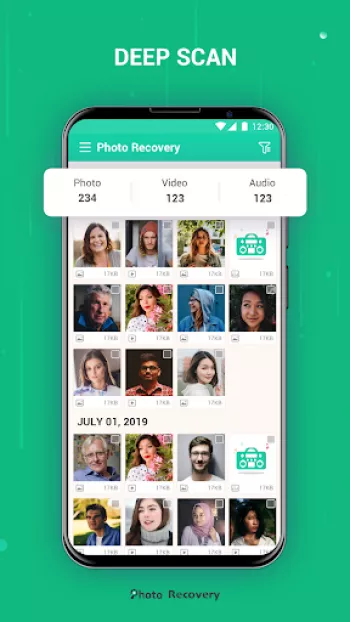Apps Zone

Photo Recovery - Restore video
Understanding File Recovery: How It Works and Why It's Essential
File recovery is an essential capability in our digital age, allowing individuals to retrieve data that has been inadvertently deleted from a multitude of devices. In the realm of file recovery, applications are designed to scan storage devices for fragments of data that have not been overwritten. When you delete a file, the operating system merely removes the directory reference to the data, leaving the physical blocks intact. This is where file recovery tools step in, scanning these blocks for recognizable data signatures and attempting to restore them to a readable state. The importance of these applications cannot be overstated; they safeguard against the permanent loss of critical data such as documents, photos, and multimedia files due to human error, software malfunctions, or even malware attacks. File recovery applications essentially give users a second chance, preventing potentially devastating loss of personal or professional information. Furthermore, these tools come with the capability to deep scan for deleted content beyond simple retrieval from a recycle bin or trash folder. This deep scanning process analyses the raw data in storage media sectors, offering users a robust recovery option. This layer of safety is not just beneficial to everyday users; businesses also rely heavily on file recovery solutions to maintain the integrity of their data archives. The strategic importance of file recovery is underscored by our increasing reliance on digital information storage, highlighting not only the technology’s necessity but also its evolution in response to ever-expanding data storage capacities and complexities.
The Role of Photo Recovery in Data Protection
The landscape of file recovery has been significantly enriched by applications such as Photo Recovery, which are tailored specifically to address the common issue of accidental deletion of media files. These applications simplify the recovery process, transforming something typically reserved for experts into a user-friendly experience accessible even to those with minimal technical skills. Photo Recovery, in particular, caters to a wide demographic, ranging from casual users looking to recover cherished family photos to professionals needing to retrieve high-resolution image files critical for their work. One of the key features setting Photo Recovery apart is its comprehensive scanning capability, which can identify lost images and videos quickly and return them to their original state on the device. Moreover, the application incorporates a filtering system that allows users to sort through data by type, size, and time, making the pinpointing of specific files efficient and less cumbersome. For instance, if a user accidentally deletes a month's worth of valuable pictures, they can use the filter tools to recover just the deleted images from that time period. The application supports a variety of media formats and provides an added layer of privacy protection, ensuring that sensitive files can be recovered securely. As users increasingly store personal and professional memories digitally, the value of such specialized recovery tools becomes evident, providing both peace of mind and efficient data management without requiring professional intervention.
Navigating the User Experience: Interface and Functionality
One of the defining elements of top file recovery applications is the quality of the user interface, which dictates how easily a user can navigate through the recovery process. Applications like Photo Recovery are specifically designed to offer a seamless user experience, reducing the technical complexities traditionally associated with data recovery. The interface is organized to guide users step-by-step, from selecting the type of file they wish to recover to viewing the recovered content. This structure is pivotal in making the application approachable for non-technical users while still providing the advanced functionality expected by more experienced individuals. In addition to ease of use, Photo Recovery also ensures a responsive interface, allowing users to initiate scans and retrieve their data quickly. Seamlessly integrated tooltips and help sections facilitate a better understanding of more advanced options, such as deep scanning or selecting specific storage sectors to focus on during the recovery process. These elements are supported by backend optimizations that improve the efficiency of both scanning and retrieval processes, thus minimizing the time taken to restore lost files. Moreover, incorporating features that safeguard user privacy and allow for file preview before full restoration are central to both usability and user confidence. By presenting a comprehensive solution that merges functionality with simplicity, Photo Recovery optimizes the data recovery experience and underscores its role as a versatile solution for a broad audience.
Technical Insights into File Recovery Technology
At its core, the technology behind file recovery is a fascinating blend of algorithmic complexity and intuitive design principles. Applications like Photo Recovery leverage advanced scanning algorithms capable of sifting through vast amounts of raw data to locate and resurrect deleted files. The efficacy of these applications is largely predicated on their ability to perform "deep scans." A deep scan involves an exhaustive search of the storage media's lower layers, bypassing the superficial file allocation structures that are often corrupted or incomplete after deletions. This involves reading through numerous data patterns to identify remnants of deleted files, deciphering them, and reassembling them into a coherent whole. Additionally, as storage technology evolves—shifting from magnetic hard disk drives to solid-state drives, for example—the underlying algorithms must adapt accordingly. SSDs, for instance, utilize data management algorithms like TRIM, which complicate recovery efforts by immediately erasing deleted data blocks, highlighting the need for recovery applications to constantly innovate. Photo Recovery exemplifies this adaptive capability by maintaining pace with such technological advancements, ensuring compatibility across a range of devices and file systems. The application is also equipped to handle diverse data structures and file types, thus broadening its utility and confirming its status as a standout solution for both everyday and critical data recovery needs. Ultimately, the precision and adaptability of the file recovery technology serve as a testament to its developers' dedication to safeguarding data integrity in increasingly complex digital environments.
Comprehensive Recovery Solutions for Every Platform
In today's interconnected digital landscape, the demand for file recovery solutions that cater to multiple platforms is more pressing than ever. Photo Recovery addresses this demand by providing users with the ability to perform data recovery operations seamlessly across various operating systems and devices. On Android devices, the app's functionality is robust, leveraging the Android file system to efficiently scan and recover lost images, videos, and audio files, all while maintaining a straightforward user interface. For users seeking solutions on other platforms, while the primary focus of Photo Recovery may be on Android, the concepts and technologies it employs are applicable across other operating systems as well. Download for Android. Cross-compatibility is crucial in an era where users frequently switch between mobile platforms and desktop environments. The versatility of file recovery applications means they must be designed to not only retrieve data but also ensure that this data is easily transferable and usable across varied digital ecosystems. The capability to recover files efficiently and port them from one platform to another without data loss or format issues is indispensable. Moreover, the presence of user support and comprehensive tutorial systems within the application further enhances its accessibility, guiding users through the intricacies of multi-platform data recovery processes. Ultimately, a comprehensive and reliable file recovery solution must embody both technical sophistication and user-centric design, creating an ecosystem where data is never truly lost, regardless of the device or system.
Share Your Opinion
Your Email Will Not Be Published.
All Rights Reserved © Apps Zone 2025





























Lemony
I thought I had moved all my files over but deleted precious pictures and videos I downloaded this app got the free trial got all my pictures and v...
Robert J Crowl
Thought I'd be able to recapture pictures that were accidentally deleted but it didn't work for the pictures that I really wanted. I guess they wer...
mommybird
It's not as bad as other reviews say. Yes, you have to pay if you want to actually download the photos recovered, and yes there are a lot of them t...
Azhar Farooq
Worst app ever, just counted a wrong number count and then keep asking to upgrade premium. Don't even give it a try 🤬🤬🤬😡😡
我的点点滴滴
A disaster to me when i try to use it. All my phone contact missing. Even though already uninstall the app but all my contact missing details such ...